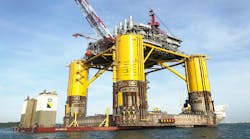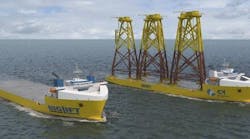Over 400 companies proposing joint projects to Petrobras
George Hawrylyshyn
Contributing Editor
Rio de Janeiro
- Brazil's sedimentary basins are to be divided into concession blocks. [61448 bytes]
- Campos Basin Development Requirements [36443 bytes]
Since last November, when the Congress in Brasilia amended the constitutional clause ending the 43-year old Petrobras oil monopoly, the state oil company has been holding "informal" talks with representatives of more than 400 foreign companies - including some state companies from other countries and private Brazilian companies. These talks range from initial contacts to sound out the possibilities, right up to offers of equipment, services, materials, and outright proposals for various types of associations in upstream and downstream sectors, including E&P projects in the Campos Basin and abroad.
"Within 120 days after the regulatory laws are approved, Petrobras will be closing deals on associations and joint ventures with other companies," Petrobras's president Joel Mendes Renno said recently. He was referring to the negotiations already underway, and he noted that the draft of the regulatory legislation that would govern the post-monopoly oil activity was scheduled to be debated and voted upon by Congress in Brasilia in August, nine months after the constitutional amendment. He also pointed out that the intention of the draft is to open the country for private company participation but stressed that Petrobras is to remain state-controlled. The federal government is to retain 50% plus one of the company's voting shares, by law.
The latter comes as a shock for oilmen not very familiar with the Brazilian oil scene. It seems to be assumed by many that the end of the oil monopoly in Brazil also meant privatization of Petrobras. Those who follow the local oil politics more closely are aware that at this stage, privatization of Petrobras - biggest company in Brazil, with an annual turnover of US$17 billion, and the 17th largest oil company in the world - is not being contemplated, although there is a strong faction within the government, Congress, and business circles that would like to introduce legislation to that effect at a later date.
There are also complaints, frequently in newspaper editorials and stories, about the long time it is taking to approve the regulatory laws as well as to the often vague wording of the draft submitted by the government to Congress. Some critics go as far as accusing the government of protecting Petrobras.
But there are defenders of the draft, even among the faction that favors a wide opening of the oil industry here. They say that given the pace of present Brazilian politics and the significance of the changes sought, the delay is understandable. As to the text of the Draft, they say pro-private enterprise congressmen have worked out a scheme to change the wording to conform to the free market spirit of the document. As for it being over-protective of Petrobras, they say it would not make sense to take away from the company everything it has achieved over the years. The significant change will be to take away former privileges and make it compete with all qualified newcomers.
Indeed, Petrobras is already introducing a more aggressive and competitive policy, but that is no easy task for someone who has dominated the country's oil scene for the last four decades. Company officials have claimed for sometime that Petrobras is competitive with the majors, especially in deep waters and through more than a quarter of a century of competitive activities throughout the world, by its foreign E&P subsidiary, Braspetro. However, the same officials admit being behind in some other aspects of technology and commercial knowhow. So the Petrobras strategy now is to go through a "period of cooperation, that is some form of associations, with foreign companies, to be followed later by outright competition." But assuming the law is passed in the expected free market terms, in theory, the industry could be open for competition almost immediately.
However, even some of the majors familiar with Brazil admit that the Petrobras "partnership model" is the best option for oil companies interested in participation in the Brazilian oil action, because of its unmatched knowledge of its home grounds. They say that even in the 20 sedimentary basins where Petrobras has not found oil or gas - the country's total is 29, but only eight are producing - or has hardly even explored, the knowledge and infrastructure the company has is invaluable for major E&P undertakings.
Curiously, the same reason that forced the Brazilian government to take the risky step of ending the Petrobras monopoly also provides an incentive to attract foreign investment: the rapidly growing demand for all sources of energy, oil and gas being foremost. After a lull in the late 1980s and early 1990s, Brazil's GDP is now growing at an annual rate of 5-7% and projections for domestic oil consumption are keeping pace - growing from the present 1.42 million b/d oil to 2.3 million b/d by the year 2005. Natural gas demand is to increase from 10 million cm/d to 40 million cm/d in the same time. Domestic production of crude has just reached the 800,000 b/d mark, which means that about half of demand still has to be imported. The government seeks investment to maintain and if possible increase the domestic supply, but for investors it means an incentive of a "captive market" for crude and gas for many years to come.
Petrobras's president Renno said at least $4.5 billion per year will have to be invested in E&P through the next five years in order to keep up with the domestic share of supply in this growing demand. That figure is basically for upstream, mainly offshore, CAPEX. If one includes downstream operations, these investments may well surpass $6 billion. The president said that in both cases that would include private capital. Renno explained that the objective of the changes is to open the Brazilian market through a modern economic development process based on partnerships and opportunities and fostered by free competition. "Challenging new business opportunities all over Brazil are merely awaiting private and state initiatives, focused on mutually profitable projects of outstanding interest to everyone involved."
Immediate business opportunities have already appeared as the first consequence of the changes. According to the draft of the regulatory laws, Petrobras will have a three-year period to define which of its discoveries are commercial and start development work to lay claim to them. The other areas will be put up for international bid. As large discoveries in Brazil have been in deep waters in the Campos Basin, Petrobras is understandably trying to lay as many stakes there as possible. In order to determine the extension and reserves of a series of still undefined strikes, the company is contracting all available deepwater DP (Dynamic Positioning) semisubmersibles and drillships, as well as providing five-year charger contracts for upgrading other drilling floaters to DP. By next year, 15 DP rigs will be busy defining the extent of oil reservoirs in Brazil's deep waters. On the development side, Petrobras might well be the only company in the world that already has contracts out for no fewer than five major projects for converting semis and oil tankers into FPSs or FPSOs. In both cases, most of the contracts went to international companies. Indeed, even before the approval of the regulatory law, there is something of a rush on Petrobras orders for seismic, drilling, and production equipment and services.
Still waiting for the approval of the law, which could be within a couple of months r at the latest early in 1997, are the middle-to-short range prospects for associations of foreign companies with Petrobras, as promised by President Renno. This would include both a boost in the Petrobras exploration program, as well as the expansion of development activities, which means the first likely participation of private enterprise, as farm-in or some other form of association with Petrobras and consequently another boost in demand for exploratory and development equipment and services.
Outright competition with Petrobras for E&P and other concessions, especially upstream, will probably take as much as two to three years. This is because it will take that long for the establishment of the petroleum monitoring agency and for it to carry out the division of sedimentary basins into concession blocks, to establish bidding procedures, to call for tenders, and to award contracts.
Copyright 1996 Offshore. All Rights Reserved.




